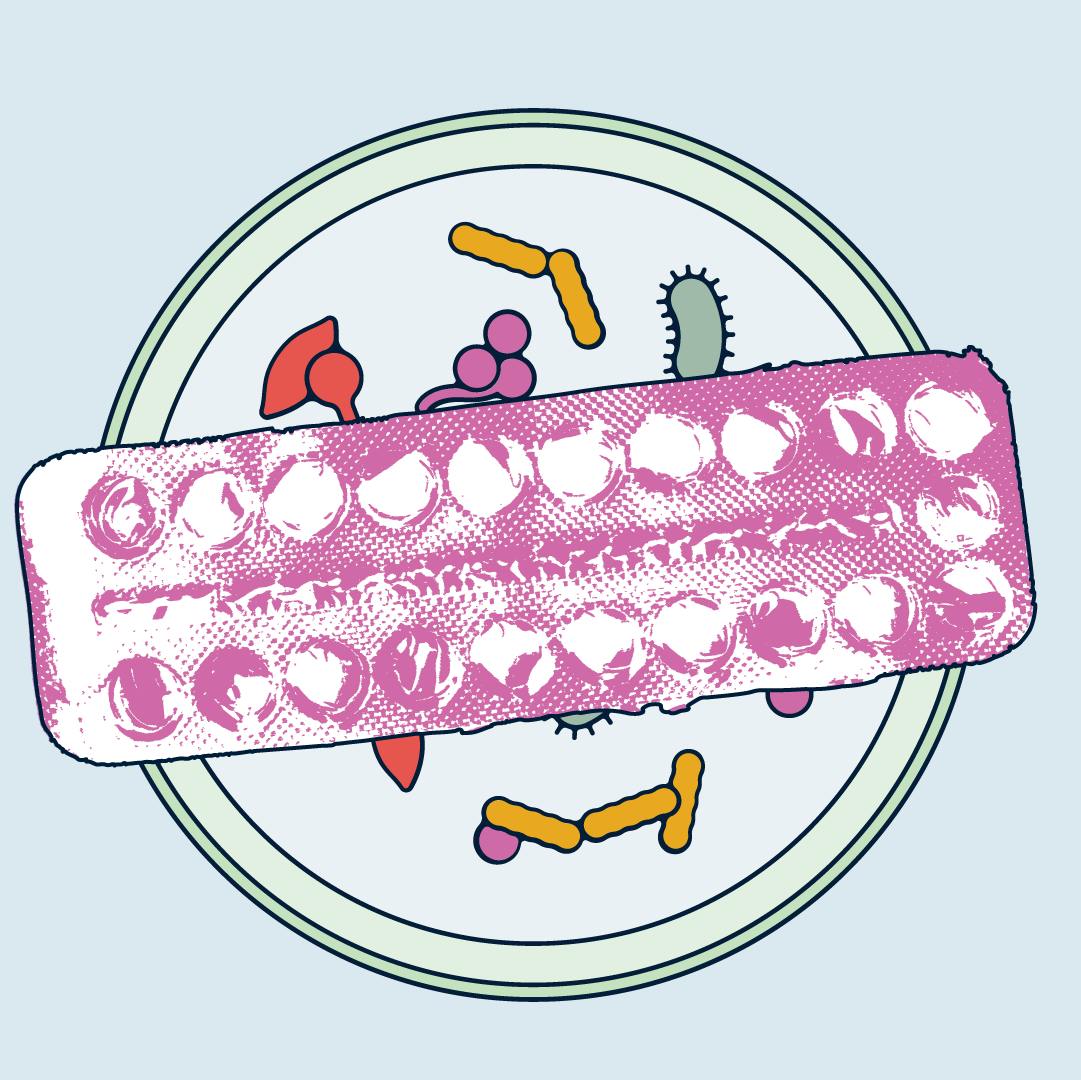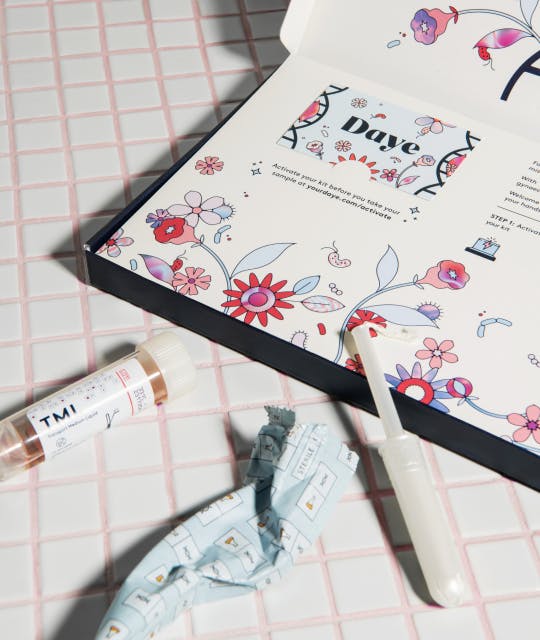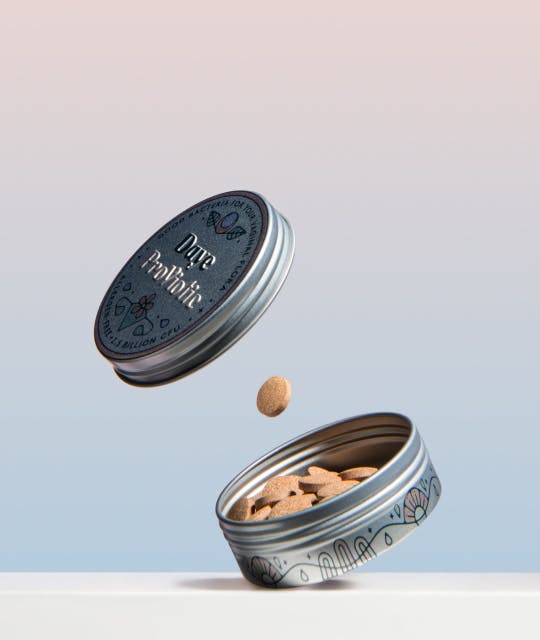Table of contents
1. Why Lactobacilli are key to a healthy vaginal microbiome
2. Our research method, explained
3. What our research says about contraception and your vaginal microbiome
4. Why the hormonal coil might be harsher on your vaginal microbiome
5. How different contraceptives affect your vaginal microbiome
6. Your vaginal microbiome matters more than you think
7. Supporting your vaginal microbiome while on contraception
8. This is just the beginning of closing the data gap
Written by Eleanor Riches
Medically reviewed by Sarah Montagu (RN DFSRH, BSc)
Illustrated by Valko Slavov
We’ve heard about the common side effects of hormonal contraception – mood changes, skin flare-ups, irregular bleeding. But here’s something you might not have been told: your contraception could be changing the natural bacteria in your vagina.
At Daye, we wanted to dig deeper. So, we did what we do best: we asked real people to help us find real answers. Using samples collected via our Vaginal Microbiome Screen, we ran one of the largest studies of its kind to explore how different contraceptive methods impact Lactobacilli (the protective bacteria that keep your vagina healthy).

Why Lactobacilli are key to a healthy vaginal microbiome
Think of your vaginal microbiome as an invisible ecosystem, home to billions of bacteria that work to keep your reproductive tract balanced, protected, and functioning smoothly.
The stars of the show are Lactobacilli: a group of protective bacteria that make up around 80% of a healthy vaginal microbiome. They’re your vagina’s built-in security team fighting against vaginal and sexually transmitted infections.
Here’s how they work:
- They make lactic acid to keep your vaginal pH low (between 3.8 and 4.5), making it harder for harmful bacteria to grow.
- They outcompete the bad guys by absorbing nutrients, leaving harmful bacteria and fungi with nothing to feed on.
- They release bacteriocins, tiny natural antibiotic-like agents that tackle unwanted microbes.
- They stop bad bacteria from sticking around (literally) by coating the vaginal walls with a protective layer and stopping invaders from latching on.
Keeping your microbiome Lactobacillus-rich is one of the best things you can do for your vaginal health. When Lactobacilli levels drop, other microbes like Gardnerella, Prevotella, or Candida can take over. This imbalance triggers a state called ‘dysbiosis’, putting you at risk of issues like bacterial vaginosis (BV), thrush or yeast, UTIs, and even STIs.

Our research method, explained
To make sure our research was rooted in real evidence, we took a super scientific approach – combining vaginal microbiome test results with questionnaire responses from over 5,000 people.
We sorted contraceptive methods into categories (like hormonal coils, condoms, and no contraception), then looked at how each method lined up with different levels of Lactobacillus.
To make sense of the data, we used a mix of statistical tools:
- Kruskal-Wallis tests to check if there were meaningful differences between groups
- Dunn’s post-hoc comparisons to pinpoint where those differences showed up
- Ordinal logistic regression to estimate how likely each contraceptive method was to impact microbiome health, while accounting for other factors
To keep things fair, all data was anonymised and grouped, and we only included results from people who completed both the test and the questionnaire.
Now, let’s get into what we found, why it matters, and how our Vaginal Microbiome Screen is changing the future of vaginal health research.


What our research says about contraception and your vaginal microbiome
Using our Vaginal Microbiome Screen (which lets you self-sample at home), we collected data from 5181 people – one of the largest ever studies of its kind!
We sorted their microbiome results into three groups:
- High Lactobacillus levels (46% of users)
- Moderate Lactobacillus levels (28%)
- Low Lactobacillus levels (26%)
Then, we looked at what contraceptive method each person was using (e.g. the IUD, the pill, condoms, ovulation tracking, etc.) and started to crunch the numbers.
Here’s what stood out:
- People using hormonal coils (IUS) were most likely to have low Lactobacilli levels: 37.5% fell into the “low” group (the most out of all methods). Meanwhile, 37.5% had high levels of lactobacilli (the least of any method).
- People using condoms had the healthiest microbiome profile: 51.5% had high Lactobacilli and only 21% had low levels (the best of any group).
- Those using non-hormonal or no contraception fell somewhere in the middle: around 47% had high Lactobacillus levels and 26% had low levels (nearly 10% less than IUS users).
Only the hormonal coil showed statistically significant differences in Lactobacillus levels compared to other methods. Hormonal coil users were 35% less likely to have high levels of Lactobacilli than those using no contraception at all (p = 0.004). In other words: not a fluke.
So, the hormonal coil may be linked to a higher risk of a disrupted vaginal microbiome because there are fewer of the good bacteria to help protect against infections.
While no contraception is perfect, these findings do raise important questions about how different methods could affect your vaginal health. The hormonal coil has many advantages, and using it certainly won’t cause vaginal infections in everyone, but if you’re someone who’s been struggling with recurrent BV or yeast, it’s worth discussing your contraception method and microbiome health with your healthcare provider.

Why the hormonal coil might be harsher on your vaginal microbiome
It all comes down to hormones and how they shape your vaginal microbiome.
Your vaginal microbiome loves oestrogen. It’s the hormone that helps keep your vagina naturally healthy by boosting glycogen (a type of sugar stored in your vaginal walls). Lactobacilli feed on glycogen and turn it into lactic acid, which keeps your vagina acidic to stop infection. However, high levels of oestrogen can encourage an overgrowth of Candida, the natural yeast responsible for thrush. So, it really is all about striking a careful balance.
Here’s where the hormonal coil (IUS) comes in. It releases a steady dose of synthetic progesterone (called levonorgestrel), but no oestrogen. This prevents pregnancy in three key ways:
- It thickens cervical mucus to slow sperm movement
- It thins the uterus lining to make implantation less likely
- It creates a hostile environment in the uterus with a physical barrier to implantation
These changes may also affect the vaginal microbiome. While the research is still emerging, some scientists believe thicker cervical mucus may trap bacteria differently, change oxygen levels, or reduce the flow of nutrients – all of which could impact Lactobacilli levels.
Higher dose hormonal coils can also suppress ovulation in some cases, which may lead to lower oestrogen levels. In the first year of using a 52mg IUS, only around 45% of users ovulate. Less frequent ovulation could mean lower oestrogen levels, which means less glycogen and less food for Lactobacilli. In most people, ovulation returns to normal six months or less after removing the hormonal coil, with no long-term impact on ovulation.
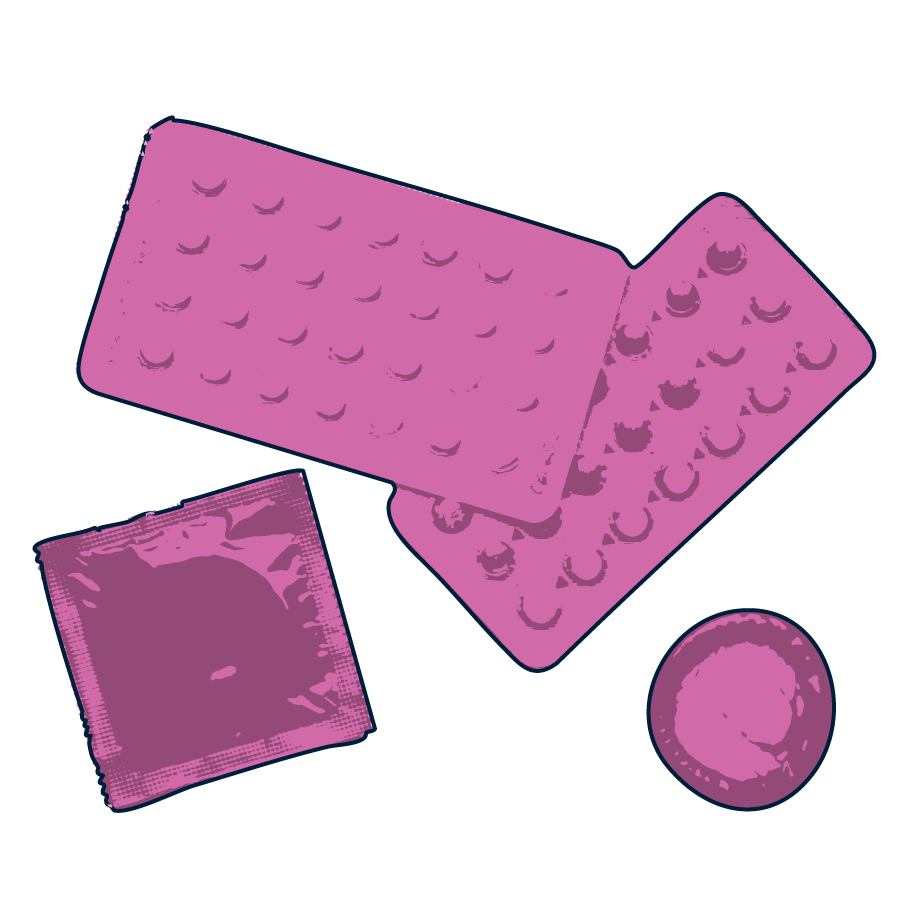
How different contraceptives affect your vaginal microbiome
Our results show a clear difference in how contraceptives affect the vaginal microbiome – and it’s not just us seeing a pattern. Let’s dive deeper into the research.
No Contraception
People not using any form of contraception had moderate microbiome health, with 47% showing high Lactobacillus levels and 26% showing low. This group gives us a useful baseline and reflects what we already know: your vaginal microbiome is unique to you and naturally shifts throughout the menstrual cycle, depending on where your hormones are at. Although it seems logical that using no contraception would support a super healthy microbiome, some research suggests that sperm can actually decrease Lactobacillus levels.
Condoms
Condom users had the healthiest microbiome profiles of any group – 52% had high Lactobacillus levels, and only 21% had low. While research on condoms and the microbiome is still limited, it makes sense: condoms don’t introduce synthetic hormones or disrupt vaginal chemistry. Since BV was recently shown to be sexually transmitted, condoms could also help protect against microbial imbalances passed between partners.
The Hormonal Coil (IUS)
Our research showed one clear trend: hormonal coil users were the most likely to have low Lactobacillus levels of any group (37.5%), while just 37.5% had high levels. Given the size of our study, that’s a finding worth paying attention to. Wider research has been mixed: some studies suggest the hormonal coil may disrupt the vaginal microbiome shortly after insertion (but it settles over time). Others found no major differences compared to other methods. Bottom line? We need more answers, but studies like ours are helping change the status quo and bridge the gender data gap.
The Copper IUD
Copper IUD users in our study showed more balanced results, with 46% showing high Lactobacillus levels and 26% showing low levels (close to the overall average). However, other research suggests copper IUDs can increase overall bacteria (by more than 5 times), without supporting Lactobacillus levels to keep the vaginal microbiome in balance.
The Pill (Combined Oral Contraceptives)
Our users on the pill also had relatively stable Lactobacillus profiles, with 47% showing high Lactobacilli and 27% showing low levels. This suggests the pill has a neutral, sometimes protective impact on the microbiome, and wider research agrees. Oestrogen in combined pills is thought to support glycogen production in the vaginal walls, which feeds Lactobacilli.
The Depot Injection (DMPA)
In our data, the injection didn’t show a strong trend either way. 50% of users had high Lactobacillus levels, while 25% had low, similar to the ‘no contraception��’ baseline. That matches the mixed findings in wider research: some studies suggest DMPA might boost certain strains of Lactobacillus and reduce BV risk, while others link it to increased bacterial diversity (which isn’t always a good thing).
The Vaginal Ring
Although our sample size for vaginal ring users was too small to draw any meaningful data, it didn’t appear to trigger any microbiome disruption. Wider research suggests that the impact may vary between individuals, with the ring being microbiome-friendly and even protective in some cases.
Your vaginal microbiome matters more than you think
Your vaginal microbiome plays a huge role in your overall health, even if you don’t always notice it. It’s involved in everything from infection prevention to fertility, vulvar comfort, and vaginal inflammation.
Lactobacilli can help:
- Protect against infection, including: BV, thrush, and STIs (like chlamydia, gonorrhoea, HPV, and HIV).
- Maintain tissue health, reduce inflammation, and lower the risk of preterm birth.
- Support embryo implantation and conception.
So, when a contraceptive method (especially one that’s commonly recommended) appears to lower those protective bacteria, we think it’s worth paying attention to.
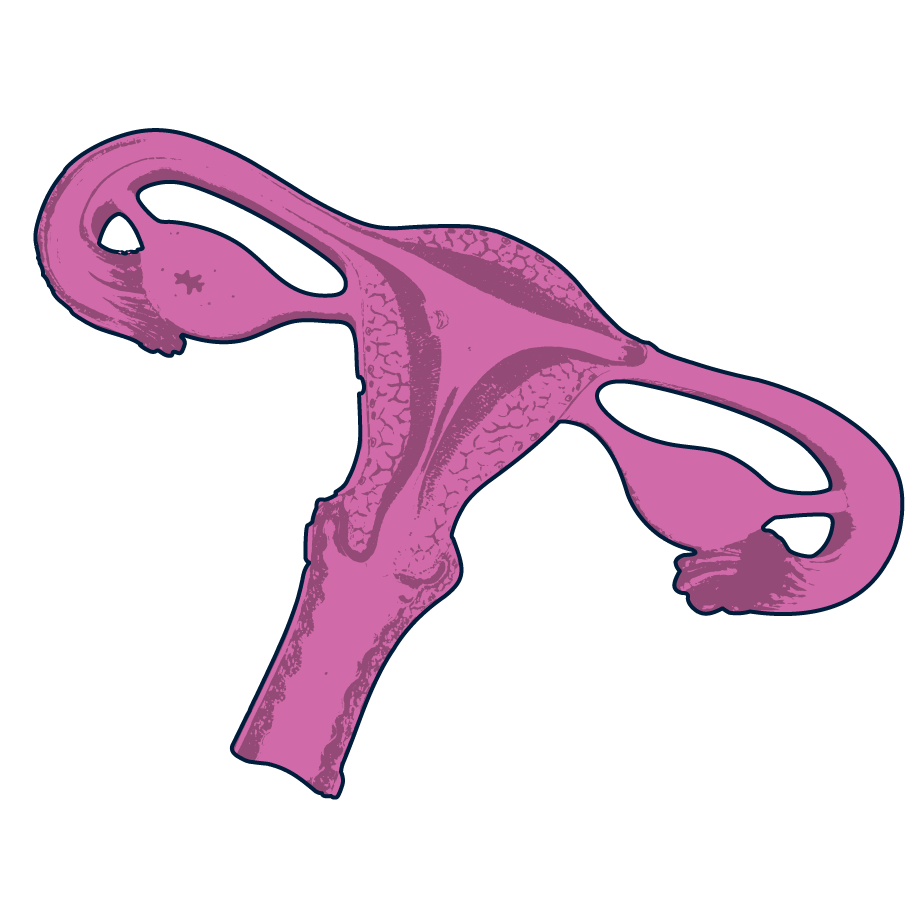
Supporting your vaginal microbiome while on contraception
Your vaginal microbiome is personal and your response to contraception will be too. Factors like your baseline microbiome, genetics, hormones, and even race or ethnicity can all affect how your body responds to different methods.
While no method is inherently “bad”, you deserve the full picture when making decisions about contraception. And that starts with understanding your own vaginal microbiome.
Here’s where to begin:
- Test your microbiome, especially if you’re switching contraceptive methods or dealing with mystery symptoms. You can now do this from home with our Vaginal Microbiome Screen.
- Pay attention to symptoms like discharge changes, irritation, or repeat infections – they could be a sign your microbiome is out of balance.
- Support your microbiome by avoiding harsh soaps, douching, and unnecessary perfumed products. A healthy diet, rich in fibre and probiotic foods, and considering probiotic supplements can also help boost your protective bacteria.
And remember: your body is unique. What works for someone else might not work for you, and that’s okay!
This is just the beginning of closing the data gap
This study wasn’t just about collecting data, it was about digging deeper into something we’re told to accept as ‘normal’. Despite how widely contraception is used, we still don’t fully understand how different methods affect the vaginal microbiome – and that needs to change.
Existing research is limited, inconsistent and rarely reflects the real lives of those using it. At Daye, we’re doing things differently. With the help of our incredible community, we’re building one of the largest real-world, anonymised datasets on vaginal health. Every sample, every insight, brings us closer to filling the gaps traditional research has left behind.
And our at-home Vaginal Microbiome Screen is making research more accessible than ever. By removing the barriers of clinical testing, we’re opening up a world of personalised healthcare approaches. From improving everyday care to guiding contraceptive choices, this is how we build a future where vaginal health is actually understood.
Figuring out your contraception shouldn’t have to be guesswork – it should be a confident, informed choice, backed by real science.
Relevant Product
Sources
Vaginal microbiota and the potential of Lactobacillus derivatives in maintaining vaginal health
https://pubmed.ncbi.nlm.nih.gov/33160356/
How To Maintain A Healthy Vaginal Microbiome
https://www.yourdaye.com/vitals/womens-health/how-to-maintain-a-healthy-vaginal-microbiome/
Vaginal microbiome: normalcy vs dysbiosis
https://pubmed.ncbi.nlm.nih.gov/34120200/
Host and Microbiome Interplay Shapes the Vaginal Microenvironment
https://pubmed.ncbi.nlm.nih.gov/35837395/
Estrogen promotes innate immune evasion of Candida albicans through inactivation of the alternative complement system
https://pmc.ncbi.nlm.nih.gov/articles/PMC8755443/
Towards a deeper understanding of the vaginal microbiota
https://pubmed.ncbi.nlm.nih.gov/35246662/
Bayer: Mirena IUS Prescription Guide
https://labeling.bayerhealthcare.com/html/products/pi/Mirena_PI.pdf
Daily Vaginal Microbiota Fluctuations Associated with Natural Hormonal Cycle, Contraceptives, Diet, and Exercise
https://pubmed.ncbi.nlm.nih.gov/32641429/
Recent Semen Exposure Impacts the Cytokine Response and Bacterial Vaginosis in Women
https://pmc.ncbi.nlm.nih.gov/articles/PMC8221111/#:~:text=After%20unprotected%20sexual%20intercourse%2C%20the,)%20(15%E2%80%9318
Male-Partner Treatment to Prevent Recurrence of Bacterial Vaginosis
https://www.nejm.org/doi/full/10.1056/NEJMoa2405404
Contraceptive effects on the cervicovaginal microbiome: Recent evidence including randomized trials
https://pubmed.ncbi.nlm.nih.gov/37881121/
An Integrative Review of the Relationship Between Intrauterine Devices and Bacterial Vaginosis
https://pubmed.ncbi.nlm.nih.gov/36803608/
Copper intrauterine device increases vaginal concentrations of inflammatory anaerobes and depletes lactobacilli compared to hormonal options in a randomized trial
https://pubmed.ncbi.nlm.nih.gov/36717556/
Lactobacillus-dominance and rapid stabilization of vaginal microbiota in combined oral contraceptive pill users examined through a longitudinal cohort study with frequent vaginal sampling over two years
https://pmc.ncbi.nlm.nih.gov/articles/PMC9792759/
The Vaginal Microbiota, Bacterial Biofilms and Polymeric Drug-Releasing Vaginal Rings
https://pmc.ncbi.nlm.nih.gov/articles/PMC8161251/
Protective Mechanisms of Vaginal Lactobacilli against Sexually Transmitted Viral Infections
https://pubmed.ncbi.nlm.nih.gov/39273118/
Cervicovaginal microbiota and local immune response modulate the risk of spontaneous preterm delivery
https://pubmed.ncbi.nlm.nih.gov/30899005/
Insights into the vaginal microbiome in a diverse group of women of African, Asian and European ancestries
https://pubmed.ncbi.nlm.nih.gov/36518275/
A Deep Dive Into Daye’s ProViotics
https://www.yourdaye.com/vitals/daye-in-the-life/all-you-need-to-know-about-dayes-proviotics/



